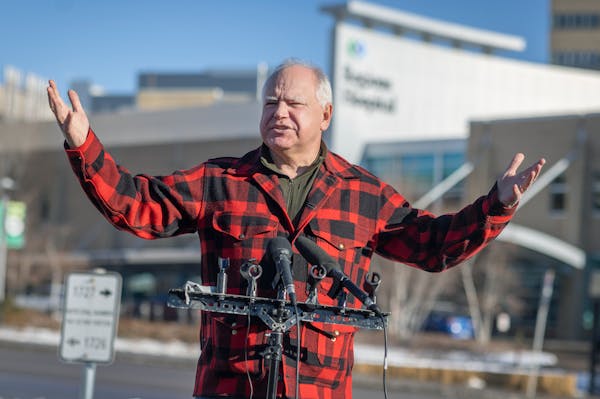The state will no longer require child care providers in Minnesota to quarantine students and staff who were in contact with someone testing positive for COVID-19, though it recommends they continue to do so.
The Minnesota Department of Human Services (DHS), which notified providers Tuesday of the change to its licensing requirements, is walking a tightrope as the surge of omicron cases frustrates providers and families alike.
The spike has wreaked havoc on early-childhood classrooms — leading many to shut down for at least a week — and the schedules of working parents with young children. Some families are at wit's end after children have been sent home to quarantine multiple times in recent months.
"We just wanted to allow some greater flexibility for child care providers to be able to make decisions on what's going to work for them, and in talking with parents, and making things work overall," DHS Commissioner Jodi Harpstead said. "So this is what we were able to do."
The revised policy does not dictate how child care providers should proceed, and some say they plan to continue their current quarantine policies. DHS said it still "strongly encourages" them to follow guidance from the state health department and the CDC.
Those agencies recommend quarantines of unvaccinated individuals following a close contact. Children under 5 cannot yet be vaccinated.
The situation is even more confusing for providers because they have been told they must abide by public health guidance on quarantines to receive monthly stabilization grants — federal money that has kept many preschools and child care centers afloat during the pandemic and has supported higher wages in an industry facing a labor shortage. But DHS, which administers those grants, has indicated it does not plan to enforce that requirement.
"We've received a little bit of mixed messages," said Chad Dunkley, CEO of New Horizon Academy, the largest child care provider in the state, and president of the Minnesota Child Care Association. "I think there's still a lot of confusion."
On Tuesday, about 1,300 of the 9,000 children enrolled at New Horizon schools were at home being quarantined because of possible exposure to COVID-19. That is the highest number since November 2020, and the number is much higher than the 100 or so kids it usually had out at any one time during most of last year.
"It's been pretty devastating," said Dunkley, adding that it's a financial challenge for providers who don't always charge tuition during quarantines and has placed a lot of stress on families. "Our parents are extremely worn out."
The end of the DHS quarantine directive is producing a mixed reaction among family-based child care providers, said Hollee Saville, president of the Minnesota Association of Child Care Professionals. Some say they'll stick with current quarantine policies but worry that parents will be angry at them for doing so.
Saville welcomed the revised policy, and she added that she expects many providers will continue to keep away children who live in homes where someone else has COVID-19.
"Child care providers have known for a long time how to keep kids safe and do what's best for kids," Saville said. "I appreciate the freedom for them to do that."
In recent months, many child care providers have been vocal in pointing out that they've had to adhere to stricter quarantine guidelines than K-12 schools. That has left them to explain to frustrated parents why, when a close contact occurs, their younger child may have to quarantine at home while older ones still go to school.
Part of that discrepancy has been because children over the age of 5 can be vaccinated and wear masks. But it's also a reflection that school districts tend to have more autonomy.
DHS will continue to enforce other COVID-19 protocols, including that child care providers report positive cases to the state health department, notify families of possible exposure and exclude children and staff who test positive from classrooms and centers.
"Our expectation is that providers are following all other COVID-19 guidance to the greatest extent possible," Harpstead said.
Even if child care providers choose to continue to follow public health guidance on quarantines, it's not always clear what direction it will take.
For example, the CDC recently shortened its quarantine recommendation to five days. But the state health department has not yet updated its guidance. which still calls for quarantines for unvaccinated individuals after close contacts of seven to 14 days. The Minnesota Department of Health said it will soon align with the CDC.
And there are other unresolved questions. The CDC now recommends that people wear masks for five days after the initial five-day quarantine is over. But because children up to the age of 2 are not supposed to wear masks, that doesn't work in a child care setting.
In the meantime, weary parents continue to scramble.
Courtney Thomas of Minneapolis got a call from her daughter's child care center on Monday asking that the child be picked up in the middle of the day because one of her classmates tested positive for the virus.
Initially, she was told it would be a 14-day quarantine. She was relieved when she heard a day later that had been shortened to 10 days. Still, Thomas is going to have to use vacation time to watch her daughter.
It's hard, she said, especially as a sole caretaker. But she's not sure she would feel comfortable either if her center didn't have any quarantines. That would help with her work schedule, but could also put her daughter at higher risk.
"It's a no-win situation," she said. "Either situation doesn't feel great."
Minnesota's med spa industry rises in popularity — and with little regulation

Ramstad: Readers say Walmart won't be paying the ultimate price of Trump's tariffs

How Minnesota businesses can spot and prevent invoice fraud
No place for cryptocurrency in retirement portfolios

